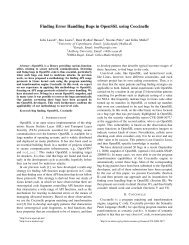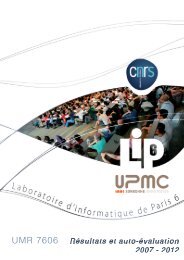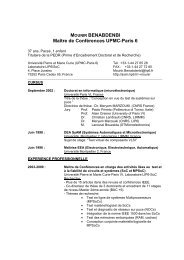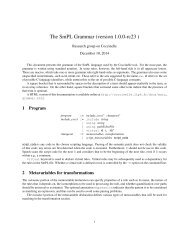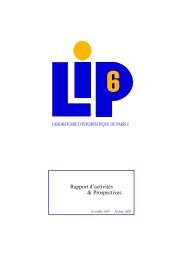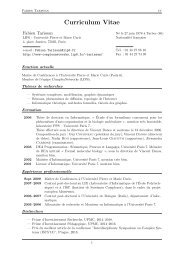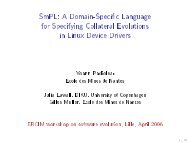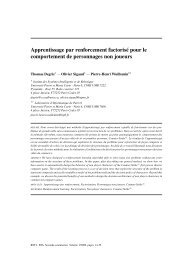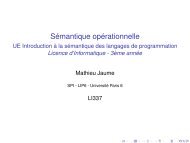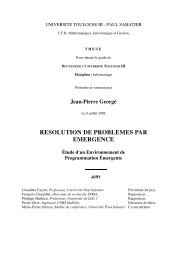Proceedings [PDF] - Measurement and Analysis of P2P Activity ...
Proceedings [PDF] - Measurement and Analysis of P2P Activity ...
Proceedings [PDF] - Measurement and Analysis of P2P Activity ...
Create successful ePaper yourself
Turn your PDF publications into a flip-book with our unique Google optimized e-Paper software.
International Conference Advances in the <strong>Analysis</strong> <strong>of</strong> Online Paedophile <strong>Activity</strong> Paris, France; 2-3 June, 2009<br />
In 2003, Taylor <strong>and</strong> Quayle wrote that, “Pseudo-photographs are constructed photographs,<br />
<strong>of</strong>ten very cleverly done with great technical sophistication, using digital reconstruction techniques to<br />
create an image that is not a photograph <strong>of</strong> a real person, or <strong>of</strong> real events. Thus the head <strong>of</strong> a child<br />
might be placed onto the body <strong>of</strong> a woman, where the body features are manipulated to make it<br />
appear to be that <strong>of</strong> a child (breast reduced in size or eliminated, <strong>and</strong> pubic hair eliminated)…”.<br />
However, while the production <strong>of</strong> such material a few years ago might have been a technological<br />
challenge, this would not be the case today. With the advent <strong>of</strong> s<strong>of</strong>tware packages such as Adobe<br />
Photoshop, the majority <strong>of</strong> us would be able to create quite complex digitally altered images. The<br />
prediction was made that easier <strong>and</strong> more accessible computer aided animation <strong>and</strong> 3D computer<br />
graphics would lead to a growth in animated child pornography. This has now happened <strong>and</strong> we see<br />
evidence <strong>of</strong> wholly constructed computer images, although it is unclear as yet what impact this might<br />
have on the availability <strong>of</strong> such image distribution. One <strong>of</strong> the primary producers <strong>of</strong> such imagery is<br />
Japan where there is a huge market in manga, <strong>and</strong> other forms <strong>of</strong> animation, that many believe are<br />
sexually exploitative. A report in the UK’s Guardian newspaper (Guardian, 2008) suggested that<br />
sexually explicit comics account for a large proportion <strong>of</strong> Japan’s Yen 500 bn manga market, with<br />
many featuring schoolgirls or childlike adults being raped or engaged in sadomasochism. However,<br />
the article suggested that manga belonging to the popular ‘lolicon’ – Japanese slang for Lolita<br />
complex – genre are likely to escape the proposed ban in Japan on the possession <strong>of</strong> child<br />
pornography, “as MPs are concerned that outlawing them could infringe on freedom <strong>of</strong> expression<br />
<strong>and</strong> drive men who use them as an outlet for their sexual urges to commit more serious sexual<br />
<strong>of</strong>fences”. However, outside <strong>of</strong> <strong>of</strong>fender accounts there is little empirical research to support this<br />
while there is evidence to suggest that such manga is <strong>of</strong>ten found as part <strong>of</strong> the collections <strong>of</strong> seized<br />
images from <strong>of</strong>fenders (Seto, 2009).<br />
In countries outside <strong>of</strong> Japan there has been a bid to criminalise the possession <strong>of</strong> nonphotographic<br />
visual depictions <strong>of</strong> child sexual abuse. In the UK a formal period <strong>of</strong> consultation began<br />
in relation to this in April 2007 <strong>and</strong> concluded in June <strong>of</strong> that year. Prior to this, the Criminal Law Sub<br />
Group <strong>of</strong> the Home Secretary’s Task Force on Child Protection on the Internet had been considering<br />
the issues raised by computer generated images (CGIs) drawings <strong>and</strong> cartoons which show graphic<br />
depictions <strong>of</strong> sexual abuse <strong>of</strong> children or child-like characters. The Consultation document recognised<br />
that these images do not involve harm to real children in their creation, but that the possession <strong>of</strong> such<br />
material was a cause for concern, particularly as technological advances have increased the<br />
availability <strong>of</strong> such material. In the summary <strong>of</strong> the responses to the Consultation, it was noted that<br />
many people viewed the definition <strong>of</strong> what would constitute ‘pornographic’ as both troublesome <strong>and</strong><br />
opaque. There was also concern that, ‘stylisations <strong>of</strong> animations freely mix aspects typifying different<br />
ages’, which would make the allocation <strong>of</strong> age subjective <strong>and</strong> therefore an impossible assessment <strong>of</strong><br />
legality. Opponents <strong>of</strong> these measures, such as the American Civil Liberties Union, have argued that<br />
people’s thoughts are their private thoughts, <strong>and</strong> that prohibition <strong>of</strong> pseudo-child pornography is a<br />
violation <strong>of</strong> free speech rights (Taylor <strong>and</strong> Quayle, 2003). However, Oswell (2006) has presented an<br />
important argument against this stating that, although the evidential value <strong>of</strong> the virtual image is<br />
different from an actual image (<strong>and</strong> hence the forms <strong>of</strong> police investigation <strong>and</strong> legal prosecution are<br />
different), until an image can be said to correspond to an actual case <strong>of</strong> child sexual abuse, all Internet<br />
child pornography can be viewed as real. In this sense, the primary concern is not one <strong>of</strong> the effects <strong>of</strong><br />
the image on others or one <strong>of</strong> the relations <strong>of</strong> power encoded in the image, but one <strong>of</strong> the virtual<br />
evidentiality <strong>of</strong> the image (i.e. on the image’s capacity to refer to an objective reality that is both<br />
internal <strong>and</strong> external to the image).<br />
Within the last few years we have witnessed the development <strong>of</strong> supranational <strong>and</strong><br />
international policy documents which set out to define ‘child pornography’ <strong>and</strong> four policy documents<br />
that are central to this issue. The European Union’s Framework Decision on combating the sexual<br />
exploitation <strong>of</strong> children <strong>and</strong> child pornography entered into force in 2004 <strong>and</strong> required member states<br />
to take steps to ensure compliance by 20 th January, 2006. Here child pornography is defined as<br />
pornographic material that visually depicts or represents:<br />
61


![Proceedings [PDF] - Measurement and Analysis of P2P Activity ...](https://img.yumpu.com/32964521/61/500x640/proceedings-pdf-measurement-and-analysis-of-p2p-activity-.jpg)

